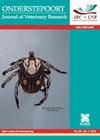An investigation into Toxoplasma gondii at the human-livestock-wildlife interface, South Africa
IF 1.5
3区 农林科学
Q2 VETERINARY SCIENCES
引用次数: 0
Abstract
Interface areas shared by humans, domestic and wild animals may serve as high transmission contexts for Toxoplasma gondii. However, knowledge about the epidemiology of T. gondii in such areas is currently limited. The present study assessed the seroprevalence of T. gondii in different hosts from Mpumalanga, South Africa. Furthermore, we investigated the local knowledge and related practices about T. gondii by conducting a questionnaire study in the community. Blood samples were obtained and analysed for T. gondii antibodies using a commercial multispecies latex agglutination kit. The seroprevalence detected in humans (n = 160; patients showing signs of acute febrile illness), cats (n = 9), chickens (n = 336) and goats (n = 358) was 8.8%, 0.0%, 4.2% and 11.2%, respectively. Seroprevalence in impalas (n = 97), kudus (n = 55), wild dogs (n = 54), wildebeests (n = 43), warthogs (n = 97) and zebras (n = 68) was calculated at 5.2%, 7.3%, 100.0%, 20.9%, 13.4% and 9.1%, respectively. The questionnaire revealed that 63.0% of household owners were subsistence farmers, and 35.9% were pet owners. A high level of female participation was found (75.3%) when compared to male participation (24.7%). The results show a low circulation of T. gondii in the domestic cycle and suggest the presence of possible bridges between the wildlife cycle and the surrounding domestic cycle.Contribution: The study contributes to identifying transmission patterns and risk factors of T. gondii within human and animal populations. This topic fits within the scope of the journal presenting original research in veterinary science, with the focus on wild and domestic populations on the African continent on a topic of universal importance.对南非人类-牲畜-野生动物交界处弓形虫的调查
人类、家畜和野生动物共同生活的交界地区可能是弓形虫的高传播区。然而,目前对此类地区弓形虫流行病学的了解还很有限。本研究评估了弓形虫在南非姆普马兰加省不同宿主中的血清流行率。此外,我们还通过在社区开展问卷调查,了解当地人对淋病的认识和相关做法。我们采集了血液样本,并使用商用多物种乳胶凝集试剂盒分析了淋病双球菌抗体。在人类(n = 160;急性发热性疾病患者)、猫(n = 9)、鸡(n = 336)和山羊(n = 358)中检测到的血清流行率分别为 8.8%、0.0%、4.2% 和 11.2%。黑斑羚(n = 97)、疣猪(n = 55)、野狗(n = 54)、角马(n = 43)、疣猪(n = 97)和斑马(n = 68)的血清流行率分别为 5.2%、7.3%、100.0%、20.9%、13.4% 和 9.1%。调查问卷显示,63.0%的家庭主人是自给自足的农民,35.9%是宠物主人。与男性参与率(24.7%)相比,女性参与率较高(75.3%)。结果表明,淋病双球菌在家庭循环中的传播率较低,并表明野生动物循环与周边家庭循环之间可能存在桥梁:该研究有助于确定淋病双球菌在人类和动物群体中的传播模式和风险因素。该主题符合《兽医科学》杂志介绍兽医科学原创性研究的范围,重点关注非洲大陆的野生和家养人群,这是一个具有普遍意义的主题。
本文章由计算机程序翻译,如有差异,请以英文原文为准。
求助全文
约1分钟内获得全文
求助全文
来源期刊
CiteScore
4.30
自引率
0.00%
发文量
13
审稿时长
16 weeks
期刊介绍:
The Onderstepoort Journal of Veterinary Research, is the official publication of the Onderstepoort Veterinary Institute. While it considers submissions from any geographic region, its focus is on Africa and the infectious and parasitic diseases and disease vectors that affect livestock and wildlife on the continent.

 求助内容:
求助内容: 应助结果提醒方式:
应助结果提醒方式:


